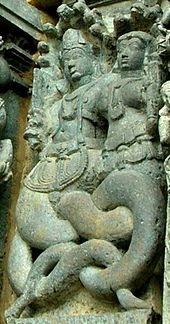

In Indian religions, Patala (Sanskrit: पाताल, IAST: pātāla, lit. that which is below the feet), denotes the subterranean realms of the universe – which are located under the earthly dimension.[1][2][3] Patala is often translated as underworld or netherworld. Patala is described as more beautiful than Svarga (subtle dimensions, loosely translated as heaven). Patala is described as filled with splendid jewels, beautiful groves and lakes.
In Vajrayana Buddhism, caves inhabited by asuras are entrances to Patala; these asuras, particularly female asuras, are often "tamed" (converted to Buddhism) as dharmapala or dakinis by famous Buddhist figures such as Padmasambhava.[4]
In Hindu cosmology, the universe is divided into the three worlds: Svarga, Bhumi or Martya (earth/mortal plane) and Patala (gross dimensions, the underworld).[5] Patala is composed of seven realms/dimensions or lokas,[6][7] the seventh and lowest of them is also called Patala or Naga-loka, the region of the Nagas. The Danavas (children of Danu), Daityas (children of Diti), Rakshas and the snake-people Nagas (serpent-human formed sons of Kadru), live in the realms of Patala.[1]
- ^ a b Wilson 1865, pp. 209–213.
- ^ Search for "patala" in: "Sanskrit Dictionary Search". Retrieved 7 January 2018. gives results: "1. one of the 7 regions under the earth and the abode of the Nagas or serpents and asuras"
- ^ Māṇi 1975, pp. 580–581.
- ^ Mayer 2007, p. 1.
- ^ Parmeshwaranand 2001, pp. 762–763.
- ^ Classical Hindu mythology: a reader in the Sanskrit Purāṇas. Translated by Dimmitt, Cornelia; van Buitenen, Johannes Adrianus Bernardus. Temple University Press. 1978. pp. 48–49, 348–350. ISBN 9781439904640.
- ^ Prabhupada. "Bhagavata Purana 5.24". The Bhaktivedanta Book Trust International, Inc. Archived from the original on 4 January 2010. Retrieved 1 July 2010.